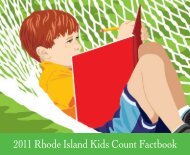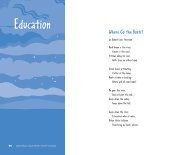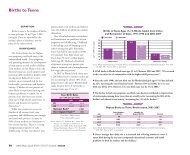2010 Rhode Island Kids Count Factbook
2010 Rhode Island Kids Count Factbook
2010 Rhode Island Kids Count Factbook
You also want an ePaper? Increase the reach of your titles
YUMPU automatically turns print PDFs into web optimized ePapers that Google loves.
Children Receiving Child Care Subsidies<br />
DEFINITION<br />
Children receiving child care subsidies<br />
is the number of children receiving<br />
child care that is either fully or partially<br />
paid for with a child care subsidy from<br />
the <strong>Rhode</strong> <strong>Island</strong> Department of<br />
Human Services. Child care subsidies<br />
can be used for care by a child care<br />
center, family child care home, a<br />
relative or an in-home caregiver.<br />
SIGNIFICANCE<br />
15000<br />
14000<br />
13000<br />
12000<br />
11000<br />
10000<br />
900<br />
800<br />
0700<br />
600<br />
0500<br />
Families rely on child care to enable<br />
them to work and to provide the early<br />
education experiences needed to<br />
prepare their children for school. Yet<br />
the high cost of child care in the United<br />
States ($3,400 - $15,900 per child per<br />
year) puts quality care out of reach for<br />
many low-income families. 1<br />
In <strong>Rhode</strong> <strong>Island</strong>, the average cost of<br />
full-time child care for an infant in a<br />
child care center consumes 44% of the<br />
median single-parent family income and<br />
11% of the median two-parent family<br />
income. The average cost of child care<br />
for two children in <strong>Rhode</strong> <strong>Island</strong>,<br />
exceeds the state’s median monthly rent<br />
and approaches the average monthly<br />
mortgage payment. 2 Using the federal<br />
affordability guideline that families<br />
should spend no more than 10% of their<br />
gross income on child care, a <strong>Rhode</strong><br />
<strong>Island</strong> family would need to make at<br />
least $91,000 per year to afford the<br />
average cost of child care for a threeyear-old<br />
at a licensed center ($9,119). 3,4<br />
Use of child care subsidies increases<br />
Child Care Subsidies, <strong>Rhode</strong> <strong>Island</strong>, 1996-2009<br />
the likelihood that low-income parents<br />
are able to work and remain employed.<br />
15,000<br />
14,000<br />
13,000<br />
14,333<br />
12,000<br />
Child care subsidies reduce the<br />
11,000<br />
10,000<br />
likelihood that former cash assistance<br />
9,000<br />
recipients return to the program and<br />
8,000<br />
7,000<br />
6,077<br />
7,471<br />
increase the range of types of child care 6,000<br />
5,000<br />
that low-income families can afford.<br />
1996 1997 1998 1999 2000 2001 2002 2003 2004 2005 2006 2007 2008 2009<br />
Families who use child care subsidies Source: <strong>Rhode</strong> <strong>Island</strong> Department of Human Services, December 1996 – December 2009.<br />
rate levels. 10<br />
have higher rates of maternal<br />
employment, more stable employment,<br />
◆ In December 2009, there were 7,471 children receiving child care subsidies in <strong>Rhode</strong><br />
and higher wages than disadvantaged<br />
<strong>Island</strong>, down from 7,700 in December 2008. The number of child care subsidies<br />
families who do not use child care<br />
increased steadily from 6,077 in 1996 to 14,333 in 2003. Since 2003, there has been a<br />
subsidies.<br />
48% decrease in the number of child care subsidies. 5,6<br />
In September 2007, the state cut<br />
In 1996, <strong>Rhode</strong> <strong>Island</strong> established<br />
income eligibility for the Child Care Assistance Program from 225% of the FPL to 180%<br />
an entitlement to child care assistance<br />
of the FPL, increased family co-payments, and eliminated eligibility for children ages 13<br />
for families with incomes up to 185%<br />
to 15, which has resulted in fewer families qualifying for subsidies. 12<br />
of the federal poverty level (FPL) as a<br />
key component of welfare reform. In<br />
◆ In 2009 in <strong>Rhode</strong> <strong>Island</strong>, 70% of children receiving child care subsidies were enrolled<br />
1998, eligibility was expanded to<br />
in a licensed child care center, 29% were enrolled in a licensed family child care home or<br />
families with incomes up to 225% of<br />
group family child care home, and 1% were being cared for by a non-licensed relative,<br />
the FPL, children ages 13-15 were<br />
friend or neighbor. 13<br />
added and rates paid to child care<br />
providers were to be adjusted biennially<br />
◆ In December 2009, 80% of all child care subsidies in <strong>Rhode</strong> <strong>Island</strong> were being used by<br />
in order to provide low-income families<br />
low-income working families not receiving cash assistance and 11% were being used by<br />
with access to high-quality child care.<br />
families enrolled in the <strong>Rhode</strong> <strong>Island</strong> Works Program who were engaged in employment<br />
7<br />
In 2007, eligibility for child care<br />
activities. Another 8% of child care subsidies were being used for children in the care of<br />
subsidies was reduced to 180% of the<br />
the <strong>Rhode</strong> <strong>Island</strong> Department of Children, Youth and Families. 14<br />
FPL ($32,958 for a family of three in<br />
2009) and eligibility for children ages<br />
Average Annual Cost for Full-Time Child Care, <strong>Rhode</strong> <strong>Island</strong>, 2009<br />
13-15 was eliminated. 8,9 In 2008, rates<br />
PROGRAM TYPE<br />
COST PER CHILD<br />
paid to providers serving children with<br />
Child Care Center (infant care) $11,374<br />
subsidies were increased slightly to the<br />
Child Care Center (preschool care) $9,119<br />
average of the 2002 and 2004 market<br />
Family Child Care Home (preschool care) $8,303<br />
School-Age Center-Based Program (child age 6 - 12) $7,067<br />
126 <strong>2010</strong> <strong>Rhode</strong> <strong>Island</strong> KIDS COUNT <strong>Factbook</strong> / Education<br />
Source: <strong>Rhode</strong> <strong>Island</strong> KIDS COUNT analysis of average weekly rates from Bodah, M. M. (2009). Statewide survey of<br />
childcare rates in <strong>Rhode</strong> <strong>Island</strong>. Kingston, RI: University of <strong>Rhode</strong> <strong>Island</strong>.






